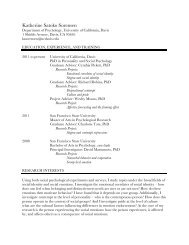The Psychology of Creativity:
The Psychology of Creativity:
The Psychology of Creativity:
You also want an ePaper? Increase the reach of your titles
YUMPU automatically turns print PDFs into web optimized ePapers that Google loves.
History <strong>of</strong> <strong>Creativity</strong> Research 20<br />
empirical data – <strong>of</strong>ten using the same raw data to make the same discoveries made by eminent scientists (Langley,<br />
Simon, Bradshaw, & Zythow, 1987; Shrager & Langley, 1990). Other computer programs have endeavored to<br />
reproduce creative behavior in art, literature, and music, sometimes with remarkable success (Boden, 1991). <strong>The</strong>se<br />
computer simulations again suggest that psychologists may have captured the basic mental processes behind the<br />
creative act (cf. Simonton, 1999a).<br />
Case studies. By introducing the mind back into psychological research, cognitive psychologists devised<br />
methods to determine the internal mental operations behind problem solving. Among these techniques is “protocol<br />
analysis” (Ericsson & Simon, 1984). Here the participants in problem-solving experiments verbalize their thought<br />
processes as they transpire, from the time the problem is first presented to the moment <strong>of</strong> the insightful solution.<br />
Transcripts <strong>of</strong> these verbal reports can then undergo detailed analysis to discern the cognitive processes involved. A<br />
natural extension <strong>of</strong> protocol analysis is to scrutinize the laboratory notebooks <strong>of</strong> eminent scientists to determine<br />
cognitive mechanisms behind genuine scientific discoveries (Gruber, 1974; Tweney, 1989). Such inquiries can<br />
enter into an iterative process with both laboratory experiments and computer simulations until cognitive<br />
psychologists converge on a single coherent account <strong>of</strong> creative thought (e.g., Kulkarni & Simon, 1988; Qin &<br />
Simon, 1990). Furthermore, these case studies can go beyond notebooks and sketchbooks to incorporate<br />
biographical materials (e.g., Gardner, 1993; Wallace & Gruber, 1989). <strong>The</strong> cognitive aspects <strong>of</strong> creativity can<br />
thereby be placed in a more comprehensive context – the creative product embedded in the creative life.<br />
Evolutionary <strong>Psychology</strong><br />
I said earlier that creativity research received a major boost with the coming <strong>of</strong> evolutionary theory. Not<br />
only did Darwin treat biological creativity in a naturalistic manner, but also he conjectured an evolutionary<br />
explanation for human creativity. Evolutionary theory provided the foundation for Galton’s path-breaking inquiries<br />
into creative genius. In the latter part <strong>of</strong> the 20th century, evolutionary thinking returned to creativity research. This<br />
revival was largely associated with the advent <strong>of</strong> evolutionary psychology, a movement that aims to explicate<br />
human cognition and behavior in terms <strong>of</strong> Darwinian principles. Applications <strong>of</strong> these principles to creativity have<br />
taken one <strong>of</strong> two courses (Simonton, 1999a). <strong>The</strong> first is to try to identify the selection pressures that, during the<br />
course <strong>of</strong> human evolution, might have favored the emergence <strong>of</strong> creativity as an adaptive behavior. In other words,<br />
creative behavior originated by the same evolutionary processes that produced other distinctive features <strong>of</strong> our<br />
species, such as bipedalism and language use. One striking example is Ge<strong>of</strong>frey Miller’s (1997, 1998, 2000)
















